OCZ Vector (256GB) Review
by Anand Lal Shimpi on November 27, 2012 9:10 PM ESTTimes are changing at OCZ. There's a new CEO at the helm, and the company is now focused on releasing fewer products but that have gone through more validation and testing than in years past. The hallmark aggressive nature that gave OCZ tremendous marketshare in the channel overstayed its welcome. The new OCZ is supposed to sincerely prioritize compatibility, reliability and general validation testing. Only time will tell if things have changed, but right off the bat there's a different aura surrounding my first encounter with OCZ's Vector SSD.
Gone are the handwritten notes that accompanied OCZ SSD samples in years past, replaced by a much more official looking letter:
The drive itself sees a brand new 7mm chassis. The aluminum colored enclosure features a new label. Only the bottom of the SSD looks familiar as the name, part number and other details are laid out in traditional OCZ fashion.
Under the hood the drive is all new. Vector uses the first home-grown SSD controller by OCZ. Although the Octane and Vertex 4 SSDs both used OCZ Indilinx branded silicon, they were both based on Marvell IP - the controller architecture was licensed, not designed in house. Vector on the other hand uses OCZ's brand new Barefoot 3 controller, designed entirely in-house.
Barefoot 3 is the result of three different teams all working together. OCZ's UK design team, staffed with engineers from the PLX acquisition, the Korea design team inherited after the Indilinx acquisition, and folks at OCZ proper in California all came together to bring Barefoot 3 and Vector to life.
The Barefoot 3 controller integrates an unnamed ARM Cortex core as well as an OCZ Aragon co-processor. OCZ isn't going into a lot of detail as to how these two cores interact or what they handle, but multi-core SoCs aren't anything new in the SSD space. A branded co-processor is a bit unusual, and I suspect that whatever is responsible for Vector's distinct performance has to do with this part of the SoC.
Architecturally, Barefoot 3 can talk to NAND across 8 parallel channels. The controller is paired with two DDR3L-1600 DRAMs, although there's a pad for a third DRAM for use in the case where parity is needed for ECC.
Hardware encryption is not presently supported, although OCZ tells us Barefoot 3 is more than fast enough to handle it should a customer demand the feature. Hardware encryption remains mostly unused and poorly executed on client drives, so its absence isn't too big of a deal in my opinion.
OCZ does its own NAND packaging, and as a result Vector is home to a sea of OCZ branded NAND devices. In reality you're looking at 25nm IMFT synchronous 2-bit-per-cell MLC NAND, just with an OCZ silkscreen on it. There's no NAND redundancy built in to the drive as OCZ is fairly comfortable with the error and failure rates at 25nm. The only spare area set aside is the same 6.8% we see on most client drives (e.g. a 256GB Vector offers 238GB usable space in Windows).
| OCZ Vector | |||||
| 128GB | 256GB | 512GB | |||
| Sequential Read | 550 MB/s | 550 MB/s | 550 MB/s | ||
| Sequential Write | 400 MB/s | 530 MB/s | 530 MB/s | ||
| Random Read | 90K IOPS | 100K IOPS | 100K IOPS | ||
| Random Write | 95K IOPS | 95K IOPS | 95K IOPS | ||
| Active Power Use | 2.25W | 2.25W | 2.25W | ||
| Idle Power Use | 0.9W | 0.9W | 0.9W | ||
Regardless of capacity, OCZ is guaranteeing the Vector for up to 20GB of host writes per day for 5 years. The warranty on the Vector expires after 5 years or 36.5TB of writes, whichever comes first. As with most similar claims, the 20GB value is pretty conservative and based on a 4KB random write workload. With more realistic client workloads you can expect even more life out of the NAND.
Despite being built on a brand new SoC, there's a lot of firmware carryover from Vertex 4. Indeed if you look at the behavior of Vector, it is a lot like a much faster Vertex 4. OCZ does continue to use its performance mode that enables faster performance if less than 50% of the drive's capacity is used, however in practice OCZ seems to rely on it less than in the Vertex 4.
The design cycle for Vector is the longest OCZ has ever endured. It took OCZ 18 months to bring the Vector SSD to market, compared to less than 12 months for previous designs. The additional time was used not only to coordinate teams across the globe, but also to put Vector through more testing and validation than any previous OCZ SSD. It's impossible to guarantee a flawless drive, but doing considerably more testing can't hurt.
The Vector is available starting today in 128GB, 256GB and 512GB capacities. Pricing is directly comparable to Samsung's 840 Pro:
| OCZ Vector Pricing (MSRP) | ||||||
| 64GB | 128GB | 256GB | 512GB | |||
| OCZ Vector | - | $149.99 | $269.99 | $559.99 | ||
| Samsung SSD 840 Pro | $99.99 | $149.99 | $269.99 | $599.99 | ||
OCZ is a bit more aggressive on its 512GB MSRP, otherwise it's very clear what OCZ views as Vector's immediate competition.


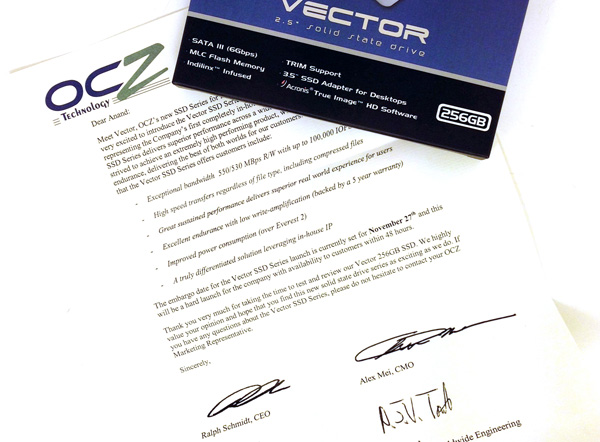
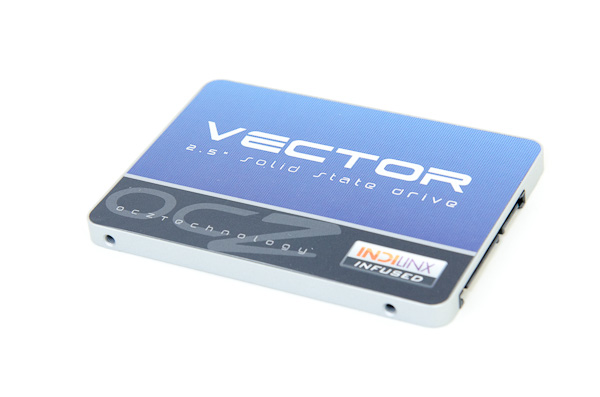
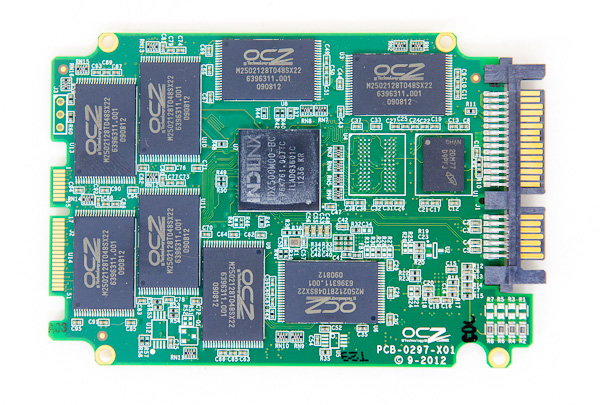
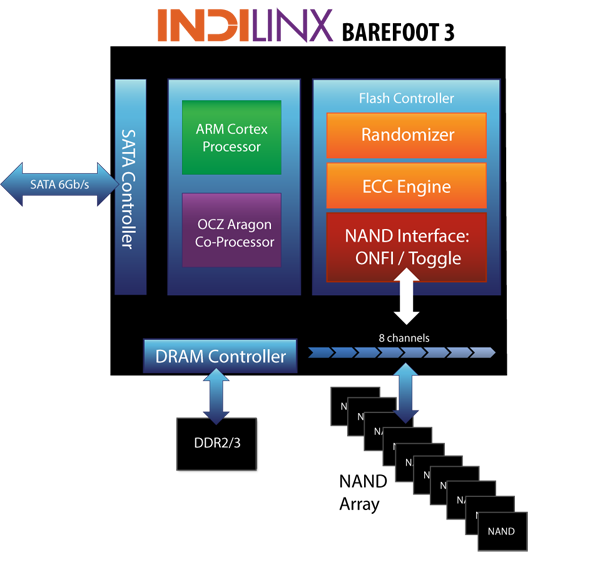
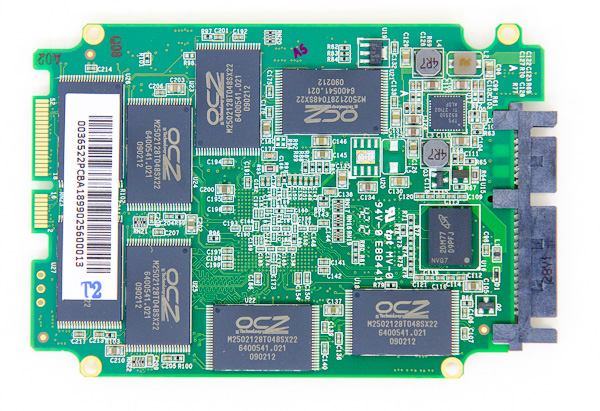









151 Comments
View All Comments
wsaenotsock - Tuesday, November 27, 2012 - link
A 5 year warranty is a pretty solid commitment on the part of a manufacturer. I don't think they would have done that if they didn't trust the stability of the hardware, so they really put their money where their mouth is.Other thing: is the Indilinx co-processor 'Argon' or 'Aragon'? Pic differs from your text description.
alacard - Wednesday, November 28, 2012 - link
Nah, you've got it all wrong unfortunately - they've bet the farm on this drive and if it fails they won't be around in five years to honor those warranties.When you've got nothing, you've got nothing to lose.
Kjella - Wednesday, November 28, 2012 - link
Well that, but I'm glad to see OCZ committing more to their drives... on my local price price check there's Agility, Colossus, Enyo, Ibis, Lightfoot, Octane, Onyx, Petrol, RevoDrive, Synapse, Vertex and Z-drive not counting numbering or variations like Vertex EX, Vertex Limitied Edition, Vertex Turbo and using a zillion different controllers and stuff. The warranty is also an indication this is the technology they'll continue working on and fixing bugs for, which is good because their attention span has been too short and spread too thin. It's better with a few models that kick ass than dozens of models that are all shoddy.MrSpadge - Wednesday, November 28, 2012 - link
Some of the drives you list are several years old..JonnyDough - Friday, November 30, 2012 - link
Furthermore, the Intel 520 (which I just purchased) got dropped off the enterprise iometer 4KB random write chart. That don't make a lick-a sense!Hood6558 - Wednesday, November 28, 2012 - link
alacard may be right, OCZ is sliding closer to the cliff as we speak. There's so much competition in the SSD market, someone's got to go sooner or later, and it will probably be the less diversified companies that will go first. I recently bought a Vertex 4 128 for my boot drive, and it lasted only 15 days before it disappeared and refused to be recognized in BIOS. The Crucial M4 128 that replaced it has the problem of disappearing every time the power is shut off suddenly (or with the power button after Windows hangs), but comes back after a couple of reboots and a resetting of your boot priorities. And it's regarded as one of the most reliable drives out there.So in order for OCZ to remain solvent, the Vector must be super reliable and stable, and absolutely must stay visible in BIOS at all times. If it's plagued by the same problems as the Vertex 4, it's time to cash out and disappear before the bankruptcy court has it's way.
Sufo - Tuesday, December 4, 2012 - link
Windows hanging? I smell problems with the user...djy2000 - Wednesday, July 31, 2013 - link
That warranty doesn't cover the most important thing. The data on the drive.Bull Dog - Tuesday, November 27, 2012 - link
Is that an m-SATA connector on the other side of the PCB?philipma1957 - Tuesday, November 27, 2012 - link
good question if I open the case can i use this as a msata?a 512gb msata is very hard to find.